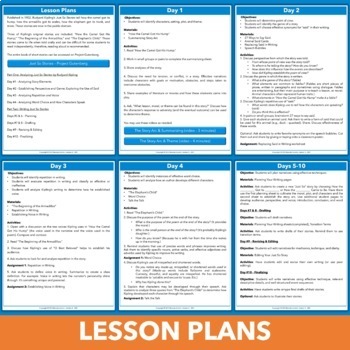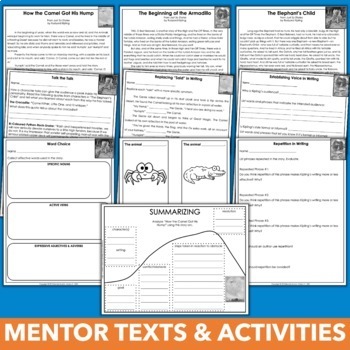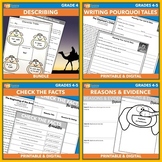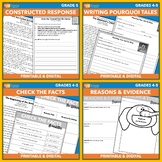Writing Pourquoi Tales with Just So Stories as Mentor Texts - 4th & 5th Grade
- PDF
- Easel Activity
Also included in
- This pourquoi tale unit has everything you need for four weeks of ELA instruction! Fourth grade students read differentiated Just So Stories; describe characters, settings, and events; write narratives; evaluate informational text; and identify claims and evidence in videos.Open the previews to takePrice $26.40Original Price $33.00Save $6.60
- This pourquoi tale unit has everything you need for four weeks of ELA instruction! Fifth grade students read differentiated Just So Stories, construct responses, write narratives, evaluate informational text, and identify claims and evidence in videos. Open the preview to take a closer look.Just SoPrice $20.00Original Price $26.00Save $6.00
Description
Kids explore pourquoi tale mentor texts from Just So Stories. Rudyard Kipling’s lively style encourages kids to experiment with word choice, repetition, and voices of the narrator and characters. After studying his work, fourth or fifth grade students plan and write their own.
Open the preview to take a closer look at the writing project.
First, kids read “How the Camel Got His Humps” and work on story elements.
- The class discusses elements of literature: characters with goals, obstacles, steps taken to overcome obstacles, climax, and resolution.
- They work in small groups or pairs to complete the story arc and summarize the pourquoi tale.
Second, they work on perspective and replacing the word “said.”
- The class discusses the perspective from which the mentor text was told.
- After discussing Kipling’s repetitive use of said, kids work in groups to brainstorm 27 synonyms. Then they use animal cards to write more said synonyms (e.g., quacked). Finally, they use synonyms to replace said in a section of the story.
Third, students read “The Beginning of the Armadillo.” They use this pourquoi tale to analyze voice and repetition.
- Kids read a second mentor text.
- Afterward, they complete a worksheet to identify Kipling’s intended audience, style, and strategies used to bring personality into his writing.
- On an additional worksheet, they analyze Kipling’s use of repetition.
Fourth, the class reads “The Elephant’s Child.” This story creates a springboard for word choice and character development.
- Students read a third mentor text.
- The class discusses Kipling’s use of made-up words in Just So Stories. Playful terms such as “flailsome and scalesome” make his narrative more fun to read.
- On a worksheet, they identify specific nouns, active verbs, and effective adjectives and adverbs used by Kipling to improve his writing.
- On a second page, students analyze three quotes from “The Elephant’s Child” to determine how Kipling developed each character through his speech.
Fifth, kids plan their pourquoi tales.
- They create a new “just so” story by choosing How the __________ Got Its __________ or How the __________ Came to Be.
- On one planning sheet, they cultivate the moral, plot, and characters.
- On the second, they establish characters, setting, and plot on a story arc.
- Additional pages help kids develop audience, perspective, and voice; introduction, conclusion, and word choice.
Sixth, they write using strategies from the mentor texts.
Finally, students edit and finalize their “just so” stories.
Files include everything you need:
- Complete lesson plans
- “How the Camel Got His Hump”
- “The Beginning of the Armadillos”
- “The Elephant’s Child”
- Story arc sheets for summarizing each passage
- Text analysis activities for finding synonyms for “said,” exploring repetition, establishing voice, investigating word choice, and considering character development through dialogue
- Pourquoi tale planning sheets
- Transition terms
- Self-editing sheet
- Comprehensive rubric
The “just so” writing project can be used in a variety of ways:
- Whole class instruction
- Small group work – enrichment, gifted and talented (g/t, GATE)
- Sub plans
- Homeschool
Printable and digital options are included:
- Easel Activities
Your students will love it – and you will too!
- Kipling’s stories are fun to read and analyze.
- Kids will gather oodles of techniques from the mentor texts.
- The step-by-step planning sheets organize their ideas and make their writing shine.
- Activities address the intent of your standards. For example, if you teach CCSS RL.4.3 or RL.5.3, your students will write narratives “using effective technique, descriptive details, and clear event sequences.” Additionally, they will use dialogue to show characters’ response to situations.
Enjoy teaching!
Brenda Kovich
Just So Stories is a collection of pourquoi tales. Also known as origin stories or etiological tales, these fanciful fables tell how something came to be or why it has certain traits. Written by Rudyard Kipling, the book was first published by Macmillan (London) in 1902. It is now in the public domain.








